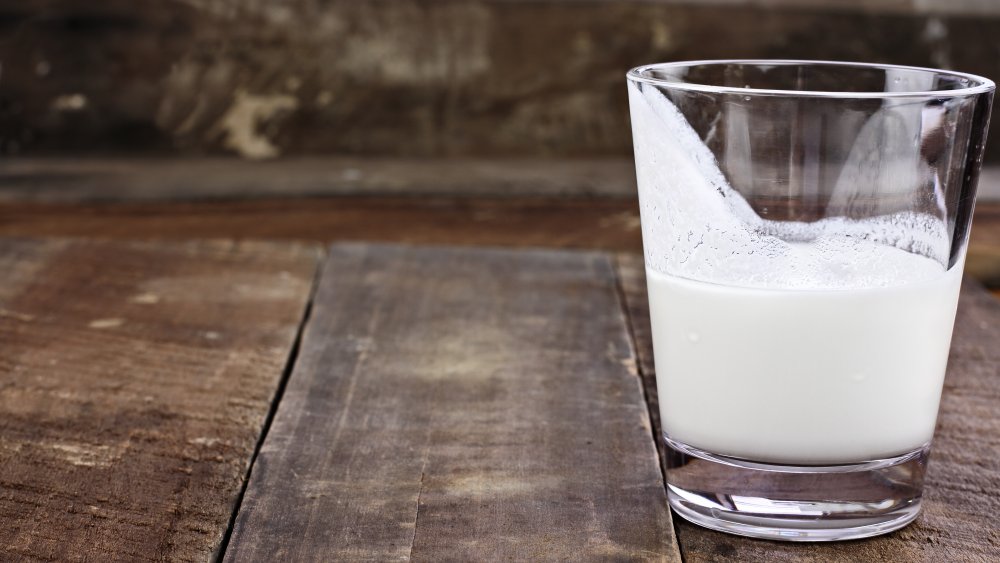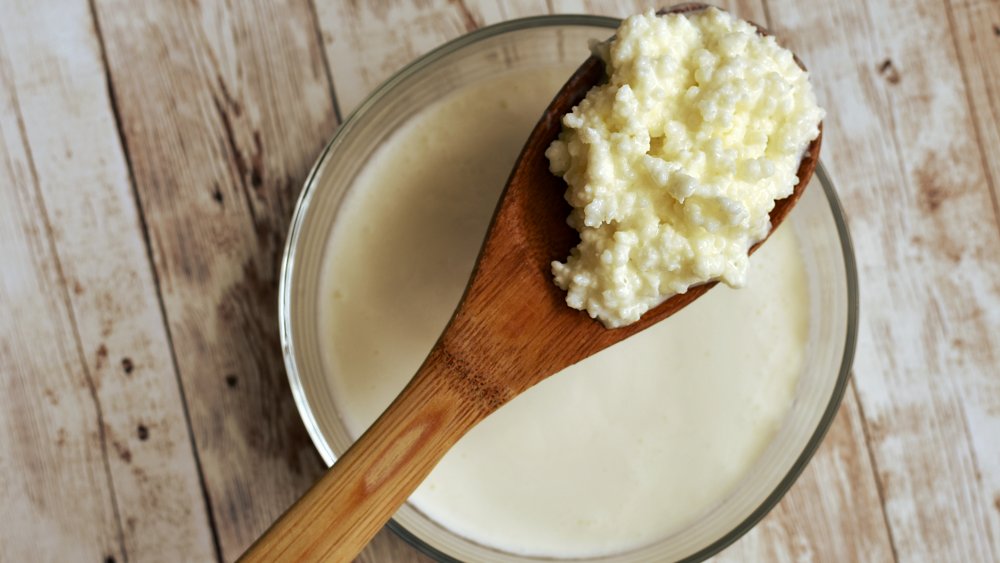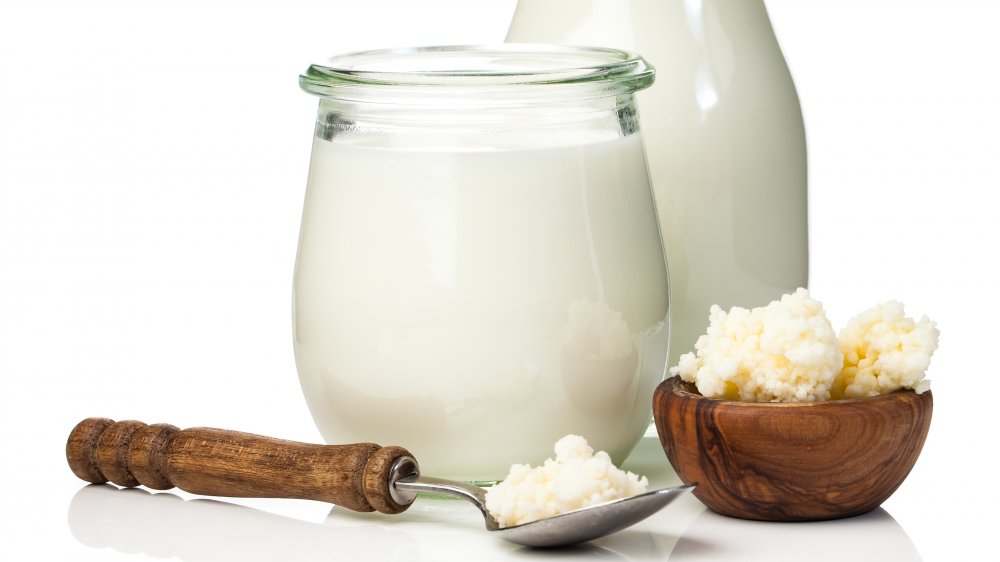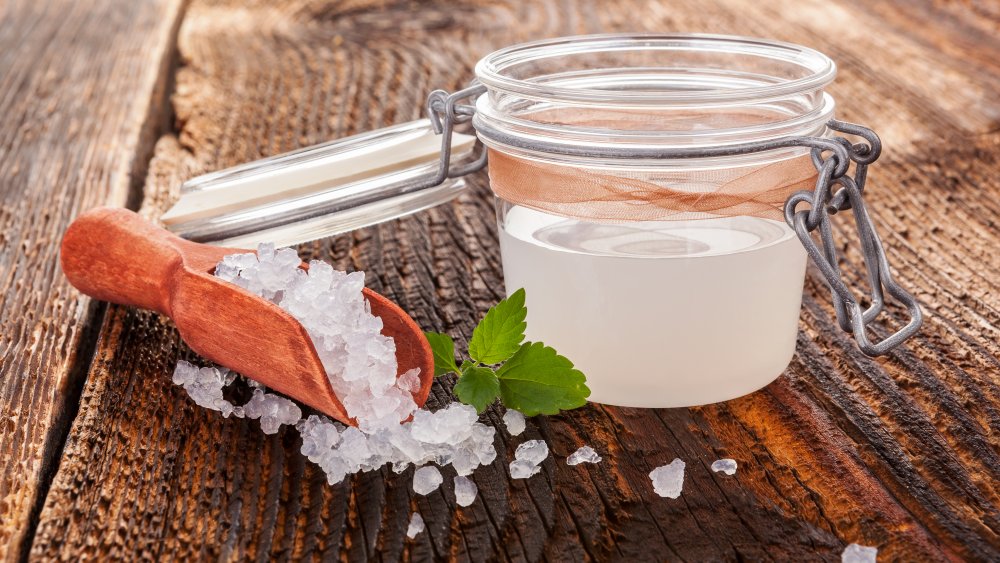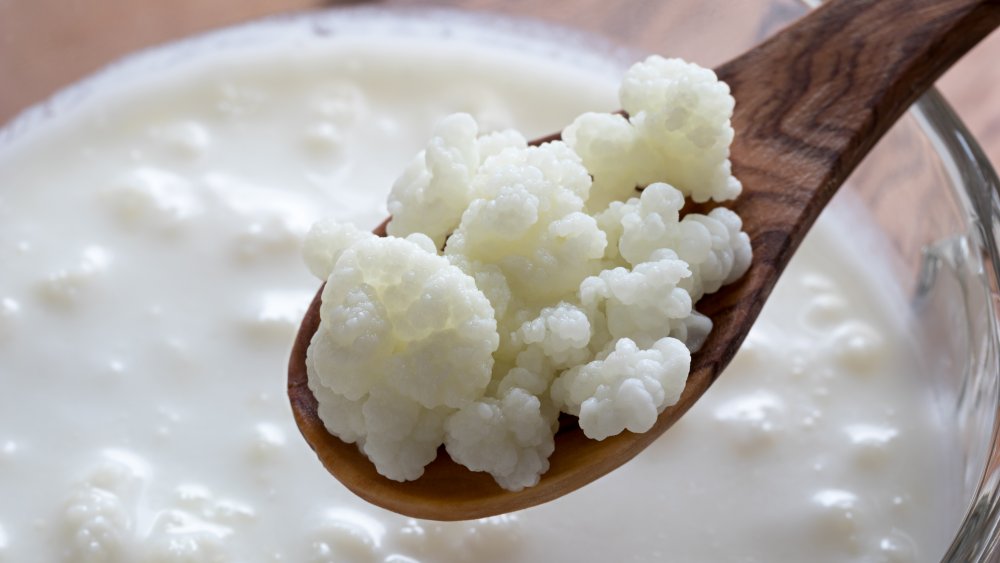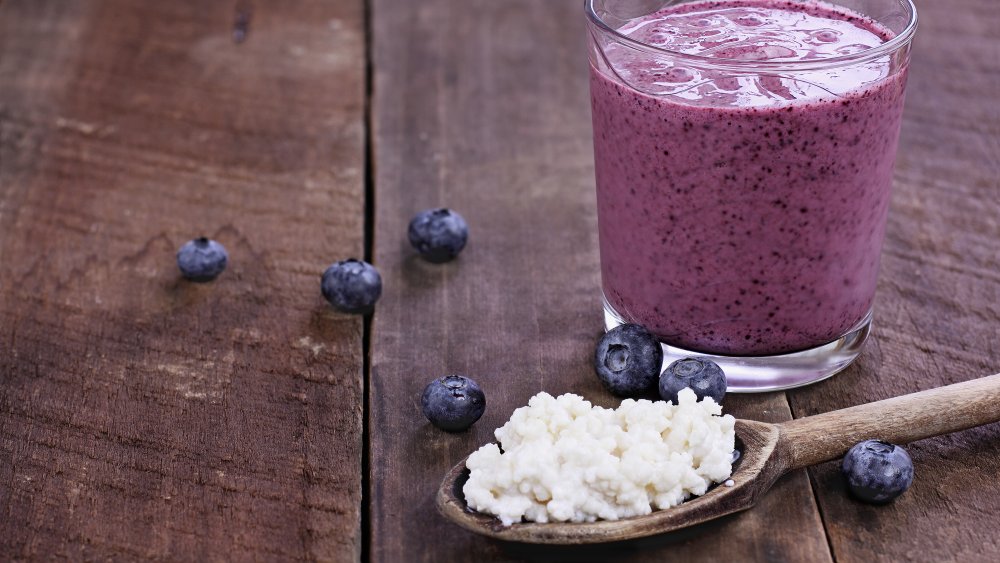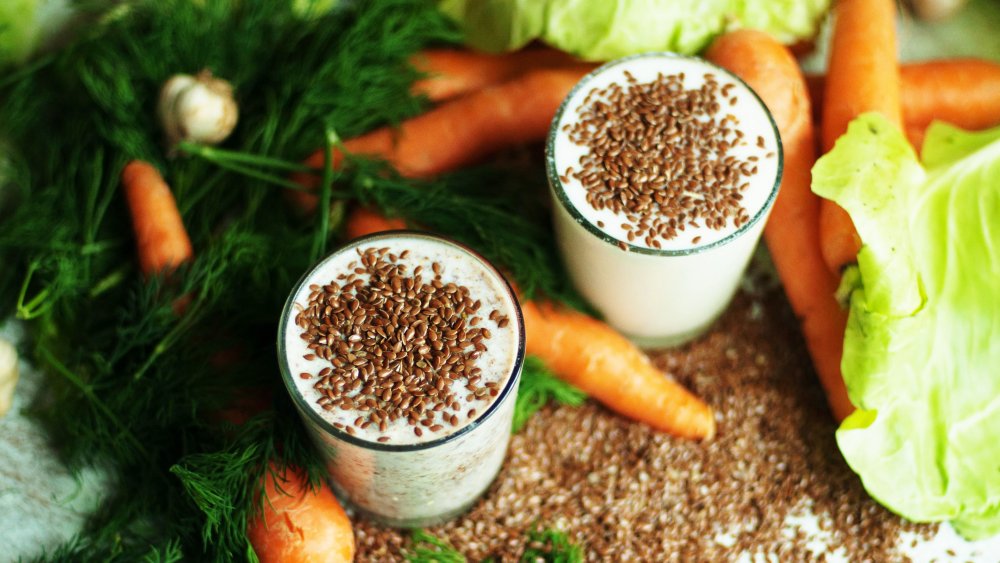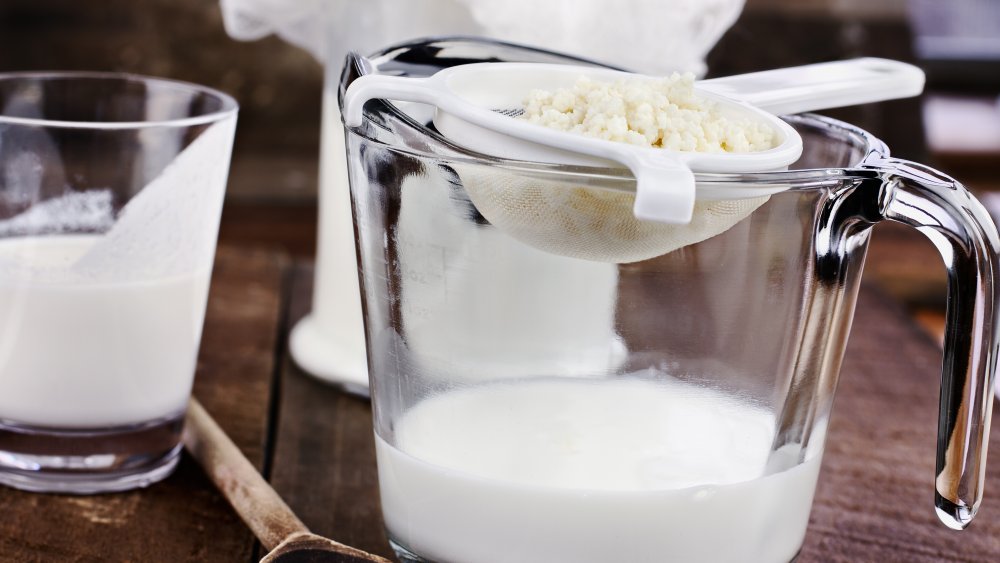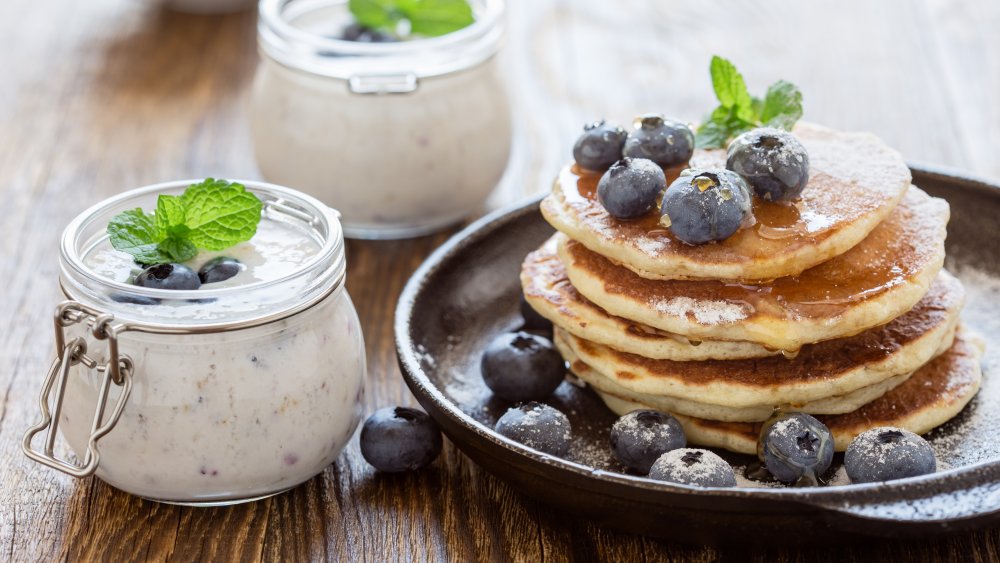Everything You Need To Know About Kefir
If you're a fan of plain yogurt, then you'll probably be a fan of kefir (pronounced keh-feer). Just like yogurt, kefir is a fermented food that has been enjoyed by people in different parts of the world for hundreds of years, but if you're just learning about its benefits now, you're not alone. As the health benefits of fermented foods started making headlines in the United States in the early 2000s, kefir, along with other "exotic fermented options" like kimchi and kombucha, started hitting grocery store shelves.
The thing about kefir is that it's somewhat of an acquired taste. Kefir is made from fermenting milk or water with kefir grains. The more popular milk version (which is usually what's found in grocery stores, although it's easy to make at home) ends up tasting a bit like plain yogurt — it has a creamy, sour flavor — but it's more liquidy than yogurt and has a slight effervescence. And, just like many people don't want to eat plain yogurt, many people might struggle to drink plain milk kefir straight. Luckily, like yogurt, it mixes well in smoothies and can be added to recipes, offering a creamy base for many baked goods. If you're looking for another way to add fermented foods to your diet, and you're ready to give kefir a try, here's everything you need to know.
Kefir dates back centuries
According to Kefir 101, there are various myths surrounding the origination of kefir, including one that suggests the Prophet Mohammed gave kefir grains (the bacteria cultures that ferment milk into kefir) with magical powers to Tibetan monks (or possibly Orthodox Christians, the folklore is not entirely clear). These monks were given strict dictate not to share the grains with others, lest the grains lose their magical powers. In a nod to this piece of folk history, common alternate names for kefir grains and kefir are "Grains of the Prophet Mohammed" and "Drink of the Prophet," respectively.
That said, this history isn't widely accepted as fact. Rather, it's most likely that kefir originated when shepherds in the Caucasus Mountains mistakenly fermented milk in their leather pouches, turning it into this alternate beverage. And only with more time and history did the shepherds start to uncover the significant health benefits associated with the drink, and rumors of its "magical powers" spread to nearby Russia, Asia, and more recently, the Western world. In fact, the Kefir 101 article notes that hospitals in the former Soviet Union used kefir to treat a number of physical ailments and illnesses, including allergies, digestive conditions, and even cancer.
It's usually made from fermenting milk with kefir grains
The most popular form of kefir is made when milk is fermented in kefir grains. According to Cultures for Health, true kefir grains have roots near the Caucasus Mountains, having been cultured, grown, and passed from one person to the next for centuries. These specific and unusual cultures of polysaccharides, primarily kefiran (hence, the name kefir), contain bacteria and yeasts that feed on milk and look a little bit like gelatinous cottage cheese. Kefir is the only fermented dairy product known to come from grains.
Because these kefir grains are made up of active bacteria and yeast, they're essentially a living organism that changes and adapts based on their environment. So, depending on who (or where) you get your grains from, and how they're being used, the makeup of the microorganisms in the grains and kefir can change.
The actual fermenting process is simple — you place the kefir grains in a bottle or container of milk for about a day and allow the grains to "feed," fermenting the milk and creating kefir. The real question is, do you want to make your own kefir, or are you happy to keep buying the pre-packaged version from the store? There's not a right or wrong answer — it's a matter of time and energy. But to make your own, you need a friend (or a website) to give or sell you grains to get you started.
Kefir can be made from water, too
While milk kefir is the more popular, well-known kefir drink, water kefir is also an option. That said, milk kefir grains and water kefir grains are different and not interchangeable. In other words, if you've been making milk kefir at home, you can't simply place the milk kefir grains in water and end up with water kefir. Or vice versa.
Rather, water kefir grains have a similar consistency to milk kefir grains, but according to Kefir 101, they're more crystalline, looking more like rock salt than cottage cheese, and the resulting drink has more carbonation-like fizziness to it, with an appearance closer to beer. These water kefir grains are placed in sugar water, juice, or coconut water, giving the grains sugars to feed on as they ferment the liquid.
Ultimately, deciding whether you want to drink milk or water kefir comes down to personal preference. Water kefir is dairy-free and often has fewer calories due to its use of water as the "food" for the culture. Also, water kefir can be flavored in a variety of ways, making it a good alternative to sodas or fruit juice drinks.
The fermenting process makes it a probiotic powerhouse
You've probably heard the word "probiotics" thrown around in relation to improving gut health, but what exactly are probiotics? According to Cleveland Clinics, probiotics are the beneficial bacteria and yeasts that live inside the body. It's completely normal and natural, and in fact healthy, to have bacteria living inside your gut that actually help combat bad bacteria and support healthy immune function. While everyone has probiotics living inside their bodies naturally, illness, stress, an unbalanced diet, and taking antibiotics can all affect the microbiome, and in some instances, wipe out healthy bacteria. Consuming probiotics in the diet can help restore a healthy microbiome and support overall health.
The thing about kefir is that it's packed with probiotics. According to an excerpt on Healthyway from the book, From Kefir, With Love: An Irreverent Guide to Making Kefir and Healing Your Gut Naturally, kefir has the most probiotics of any naturally fermented food, with between 30 and 50 strains of bacteria. The author, Whitney Wilson, goes on to explain that kefir is one of the only probiotics that can help repopulate the gut's good bacteria, rather than simply passing through the digestive system. Even though the composition of kefir can change from batch to batch, or can adapt to different environments, the vast number of bacteria and yeasts found in milk kefir is rather impressive.
And it has more probiotics than yogurt
One of the major selling points of yogurt is that it's a probiotic powerhouse, right? But if the main reason you've incorporated yogurt into your diet is for its probiotics, it may be time to make the switch to kefir. According to an article on Healthline, kefir grains contain up to 61 strains of bacteria and yeast. This is far more bacteria than other fermented dairy products, and some fermented dairy products (like yogurt), don't contain any strains of yeast.
But more significantly than that, according to Cultures for Health, which sells starters for yogurt and kefir (thus, not really preferring one over the other), the bacteria in milk kefir has the ability to colonize within the intestinal tract, which can help improve and enhance gut health over time. Yogurt, on the other hand, contains transient bacterias, which provide food for the healthy bacteria already found in a healthy gut, but they pass through the tract without colonizing within.
And it's packed full of nutrition
Milk kefir isn't just full of gut-healthy probiotics, it's packed full of nutrition, too. Generally speaking, milk kefir is made from whole milk (although if you're making your own kefir at home, you can use low-fat milk if you like). As such, the nutrition content you typically find in milk is also found in kefir. According to an article on Well.Org, a 6-ounce serving of kefir delivers between 3-6 grams of fat (depending on the type of milk used), 6 grams of protein, 7-8 grams of carbohydrate, 20 percent of the recommended dietary allowance (RDA) of both calcium and phosphorus. In that same serving, you'll also find 14 percent of the RDA for vitamin B12, 19 percent of the RDA of riboflavin, 5 percent of the RDA of magnesium, and small amounts of vitamin D, K2, organic acids, and peptides.
Of course, nutrient profiles can vary somewhat depending on what type of milk used. And if you're making non-dairy kefir, like water kefir, or milk kefir from coconut milk, the nutrient profile would change accordingly, mirroring the base that you use to ferment the kefir.
It's generally safe even for people who are lactose intolerant
According to Healthline, it's estimated that roughly 75 percent of the world's population experiences digestive discomfort after consuming dairy products. This discomfort (which ranges from gas to bloating to diarrhea), is termed "lactose intolerance" and refers to a person's inability to digest the carbohydrate found in dairy — lactose. It's a real bummer for people who have a penchant for cheese and ice cream, but end up suffering the consequences if they choose to indulge.
But, there's some good news for lactose-lovers when lactose doesn't love them back. According to a study published in the Journal of the American Dietetic Association in 2003, consuming kefir may improve lactose digestion and tolerance. When kefir was studied next to milk and yogurt, breath hydrogen levels for milk (which helped determine how well the lactose was being digested) were much higher than for plain yogurt or plain kefir. And when it came to digestive discomfort, all the yogurts and kefirs (plain and flavored) reduced the perceived severity of abdominal symptoms by between 54 and 71 percent.
So if you're looking to slowly add lactose to your diet, kefir (or yogurt) might be a good place to start. Just make sure you're sticking to plain flavors, which seem to be tolerated best — you can always add fruit or honey on your own.
It's good for pregnant women, too
As beautiful as it is to bring new life into the world, any woman who has been pregnant knows that there are some unfortunate side effects (i.e., symptoms) that rear their heads during pregnancy. And as unfortunate as it is, many of those symptoms are gastrointestinal in nature. According to the Mayo Clinic, some of the most common gastrointestinal symptoms that pregnant women face are diarrhea, constipation, and in some cases, Irritable Bowel Syndrome. Because probiotics (and kefir, specifically) are helpful in addressing gastrointestinal problems, according to the American Pregnancy Association, many pregnant women take a probiotic supplement during pregnancy.
The good news is, a study published in Canadian Family Physicians in 2011 found that probiotics are considered safe for use during pregnancy. That said, there's no reason pregnant women can't look to bolster gut health naturally by consuming probiotic-rich foods, and kefir is a good choice because it can colonize in the intestines and improve gut health with time.
Kefir can improve bone health
Strong bones are essential for maintaining overall health with age. Individuals who experience bone loss (osteopenia or osteoporosis, depending on the severity of the loss) are more likely to experience bone fractures, which can significantly impact a person's quality of life and can even lead to an early death. In fact, a 2010 study published in the Geriatric Orthopaedic Surgery & Rehabilitation journal found that while the relative risk of mortality in elderly individuals increases 4 percent per year, those who suffer a hip fracture see a substantial risk of 1-year mortality. Specifically, the year after sustaining a hip fracture was linked to a 14 to 58 percent increase in the likelihood of death. That seems like a pretty good reason to bolster bone strength when you're young, right?
According to an article on Healthline, kefir appears to be a good way to increase calcium intake to meet recommended daily allowances. Plus, kefir contains vitamin K2 in addition to calcium, which helps enhance calcium metabolism and can help reduce the risk of fractures.
It might even help allergies and asthma
One truly surprising benefit of kefir is that it may help reduce the symptoms of allergies or asthma. While studies to this effect are still limited, and mostly focused on animals rather than humans, there's some evidence that kefir can suppress airway inflammation associated with asthma. In a 2007 study published in Immunobiology, researchers administered kefir to mice an hour before inducing airway inflammation that would mimic asthma symptoms. For mice that were given kefir, the increase in inflammatory cell count was significantly inhibited, leading researchers to note: "kefir displayed anti-inflammatory and anti-allergic effects... and may possess new therapeutic potential for the treatment of allergic bronchial asthma."
But to be clear, this study was performed on mice, not humans, so please don't go replacing your inhaler with a cup of kefir. That said, if you're looking for a natural way to support your other asthma and allergy symptoms, kefir may be able to help you out, and in all likelihood, it won't hurt you.
You can make your own kefir at home
While you can always grab a bottle of pre-made kefir off your grocery store shelf, kefir is surprisingly easy to make at home. Really, the only ingredients you need to make kefir are kefir grains and milk. You can ask a friend who makes kefir to "grow extra grains" for you, or you can purchase dehydrated grains from an online retailer.
Once you have your milk and kefir grains in-hand, it's really a matter of mixing the two and allowing the fermentation to do its thing. Cultures for Health notes that you need a clean glass jar, a breathable cover for the jar (like a coffee filter or paper towel), and something to secure the cover to the jar (a large rubber band or a string, for instance). Then, you simply place the grains in the jar and add milk — roughly 1-tablespoon of grains for each cup of milk (a 4-tablespoon/4-cup ratio is usually what's suggested in recipes) — securely covering the jar with your preferred cover.
The jar can be placed on your counter, allowing the milk to ferment for about 24 hours. Once the kefir is fermented, stir the mixture with a non-metal spoon and transfer the kefir to a separate glass container, using a strainer to remove the kefir grains. Just like that, your kefir is ready! You can store it in your fridge, and start fermenting your next batch of kefir immediately.
You can use kefir in lots or recipes
The beauty of kefir (beyond its health benefits) is that it's easily incorporated into recipes in place of milk or yogurt. An obvious (and delicious) place to use kefir is in smoothies. You can simply use the liquid in place of water, milk, or yogurt, enhancing your daily probiotic intake when you make the switch. Buttered Side Up offers three fun kefir smoothie recipes (including a strawberry cheesecake smoothie) that are worth a try, although really, you don't need a fancy recipe — just throw blueberries, a banana, a handful of spinach and some kefir into your blender and whip up a tasty, nutrient-packed breakfast in minutes.
But smoothies aren't the only way you can put kefir to use. According to Kefir 101, you can incorporate kefir into bread, cultured vegetables, or even guacamole. And Health Food Lover offers more than 80 ways you can use milk kefir in your cooking, offering ideas like kefir-based pizza dough and kefir-infused cakes. And if you ever run out of ideas, Pinterest is your best friend. You're unlikely to run out of ways to use kefir while scrolling through other people's blog posts about kefir.
